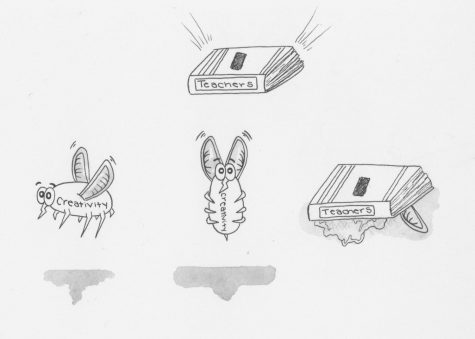Header goes right here
Thesis goes here. Thesis should directly respond to the given prompt and provide a clear line of reasoning. It should organize and serve as a roadmap for your essay.
My fingers paused, hovering over the keyboard, ready to string together sentences and paragraphs into a simple, polished 1,000-word essay. The only problem? There were no words to type.
Claim goes here. Claim should clearly state the focus of each paragraph. It should provide a preview of details and reasoning.
Ever since kindergarten, when we scratched out sentences in awkward capital letters about the time we went to the park or had a playdate, I’ve loved to write. Throughout elementary school, we wrote personal narratives, poetry and even works mimicking different children’s books like “Little Miss Sunshine.” We learned about similes and metaphors and were implored to incorporate them into our writing along with colorful descriptions, infusing our creations with emotion.
Evidence goes here. Evidence should be specific. It should support the topic sentence.
Then there was middle school. In the writing assignments typed on our cool new netbooks, there was plenty of room for creativity. In seventh grade, my favorite assignments were short stories, five to 10 pages of fiction about whatever we wanted. I titled one story, “Wake Up,” starring a dyslexic girl, bullied at school, who is suddenly able to control her dreams. Not necessarily the next entry on the “New York Times” bestseller list, but it was assignments like those which fostered my creativity, allowing me to dream up characters and themes and to see where they took me. The only limit was my imagination.
But middle school was also when we started to write the dreaded, monthly “on demand essays.” We were forced to read articles and watch videos and then write five-paragraph essays responding to specific prompts while providing textual evidence painstakingly cited from somebody else’s scientific research. I hated those things. Yes, it is important to develop those skills in analytical writing and critical thinking, but there was always a right answer, a specific formula which constricted and contained our thinking.
I say, let that thinking run wild.
Analysis goes here. Analysis explains the significance of each piece of evidence. It should connect the evidence to the claim to prove the claim.
And now, high school, notorious for its brutal, headache-inducing essays, whether they be analytical, document-based or even in our foreign language classes. From comparing time periods in history to analyzing novels, I feel my creativity is being squashed. Don’t get me wrong, we have had assignments which offered the opportunity to pull bizarre, original ideas from the depths of our minds, but we have primarily been taught to write structured essays directly responding to a given prompt, organized down to the very last comma. No more, no less.
Conclusion goes here.
Can’t we put the formulaic writing aside for once? Give us the chance to let our ideas take us where they may, to morph and change into something new and unexpected, rather than packaging up each idea in one thesis in the beginning and sticking to that. Let us dig up our crazy, weird and beautiful ideas and spill them onto a page.


